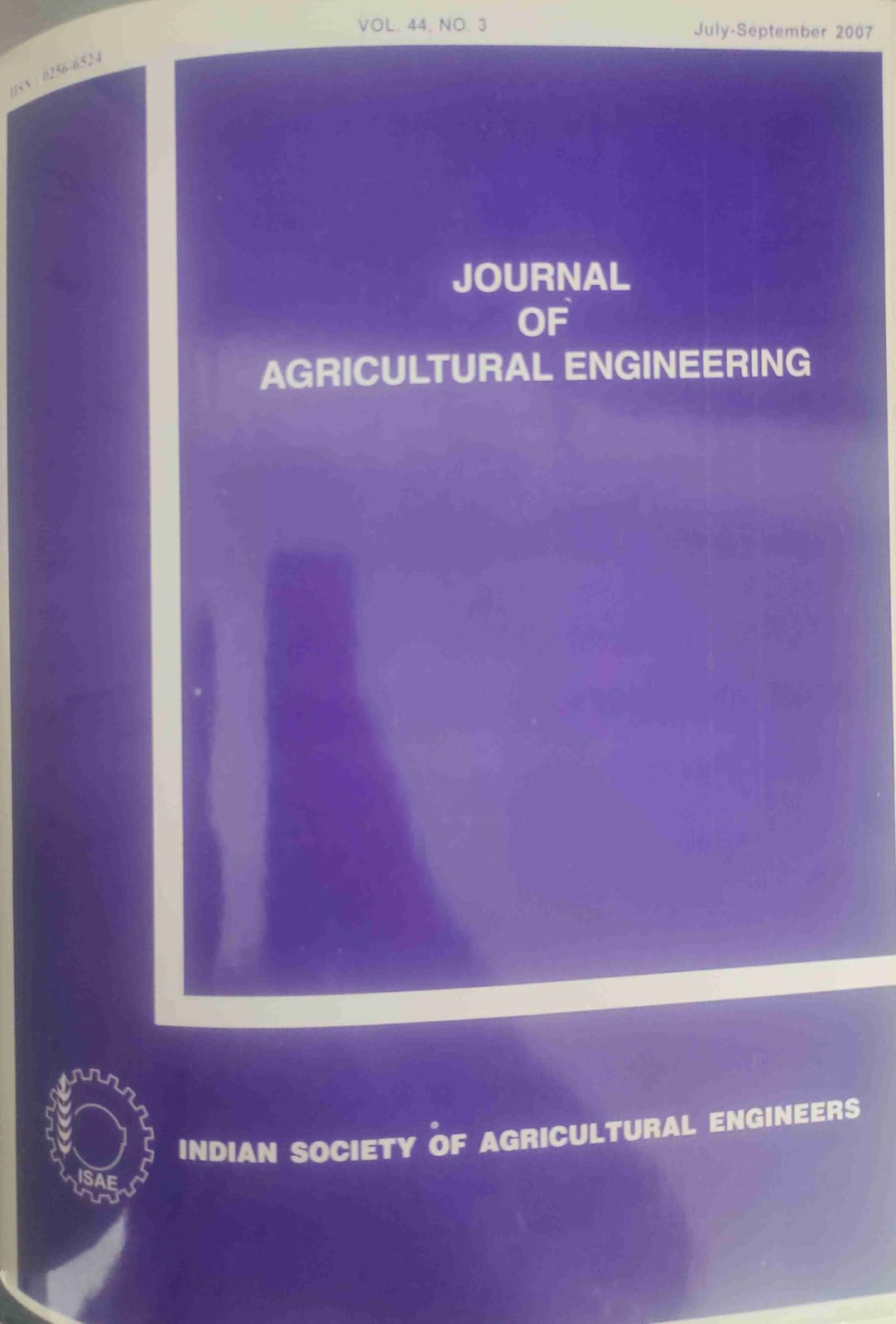Ergonomic Evaluation of Push-Pull Type Weeders with Women Operators
DOI:
https://doi.org/10.52151/jae2007443.1280Abstract
Evaluation of three weeders namely, rotary peg weeder (RPW), wheel hoe (WH) and wheel finger weeder (WFW) showed that WFW had highest effective field capacity (0.0315 ha/h) and weeding index (77.2%) followed by WH (0.0295 ha/h and 71%) and RPW (0.0195 ha/h and 70.80%). The pushing force to operate the weeder was 142±3.09, I64±4.22 and I26±2.3 7 N in case of RPW, WH and WFW respectively. The working heart rate varied between 115.80±1.47 to 128.70±1.67 beats/min with the highest value in case of WH and the lowest in case of RPW and the work pulse (HRwork -HRrest) was found to be above the allowable limit of 40 beats/min for WH (50±0.89) slightly below than that for RPW (39±1.58 beats/min) and WFW (38±1.85 beats/ min). Work Load (WL), which is oxygen consumption rate (OCR) as percentage ofV02 max' was found to be 34±3.2, 52±2.3 and 37±1.74 % for RPW, WH and WFW respectively. The Acceptable Work Load (AWL) for Indian workers is 35 % of the V02 max' The energy expenditure rate (EER) was found to be maximum in WH (19.53 kJ/min) hereas it was 13.67 kJ/min and 12.8 kJ/min in case of WFW and RPW, respectively. The body parts discomfort score revealed that WFW was more comfortable to operate followed by RPW and WH. The grading of work showed that weeding with WH was heavy work whereas it was moderately heavy with RPW and WFW for women operators.
References
Anonymous. 2005. Anthropometric survey of agricultural workers. Annual Report of AICRP on Ergonomic and Safety in Agriculture. OUAT, Bhubaneswar.
Anonymous. 1981. Testing, valuation and modification of weeders. Tech. Series No. II. Economic and social commission for Africa and Pacific. RNAM, Bangkok.
Astrand P 0; Rodahl K. 1977. A text book of work physiology. Mc Graw Hill, New York.
Corlett N E; Bishop R P. 1976. A technique for assessing postural discomfort. Ergonomics. 19, 175-182.
Gite L P. 1993. Ergonomics in Indian agriculture – A review paper presented in the international workshop on human and draught animal powered crop production held on January 19-22 at Harare, Zimbabwe.
Gite L P; Singh G. 1997. Ergonomics in agriculture and allied activities in India. Tech. Bulletin No. CIAE/97/70. CIAE, Bhopal
Kroemer K H E; Grandjean E. 2000. Fitting the tusk to the human. A text book of occupational ergonomics. Fifth Edition. Taylor and Francis Ltd., U.K.
Kroemer K HE; Kroemer H J; Kroemer-Elbert K E. 1997. Engineering physiology. Van Nostrand Reinhold. New York.'
Martiz J F; Morrison J; Peters N B; Wyndham C H. 1961. A practical method of estimating an individual's maximum oxygen uptake. Ergonomics, 4 (2),
Nag P K; Dutt P. 1979. Effect of some simple agricultural weeders with reference to physiological responses. J. Human Ergology, 5, 13-21.
Nag P K; Dutt P. 1980. Cardiorespiratory efficiency in some agricultural work. Applied Ergonomics, II, 8184.
Rodahl K. 1989. The physiology of work. Taylor and Francis, London.
Saha P N; Dutta S R; Banerjee P K; Narayane G G. 1997. An occupational workload for Indian workers. Ergonomics, 22 (9), 1059-1071.
Singh S P; Gite L P; Agarwal N. 2006. Ergonomical assessment of manually operated seed drills for farm women. J. Agric. Engng., 43(1), 42-48.














